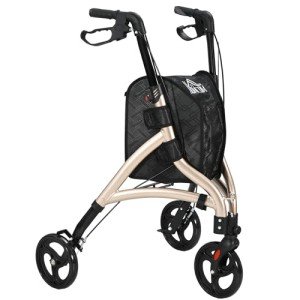0 Jobs Available Now
Trusty job portal lets companies & candidates create profiles,publish job postings, and manage them.
Candidates can search and apply for jobs
Guide To Rollator Walker: The Intermediate Guide In Rollator Walker

The Comprehensive Guide to Rollator Walkers
As the population ages, the demand for mobility aids like rollator walkers has surged. These walkers supply stability, support, and liberty of motion for individuals dealing with mobility problems, be they short-lived or persistent. Understanding the types of rollator walkers readily available, their benefits, features, and how to select the best one can considerably improve the quality of life for both the user and their caretakers.
What is a Rollator Walker?
A rollator walker is a mobility aid designed to assist people maintain their independence while walking. It includes a frame with four wheels, hand brakes, and a seat, making it suitable for users needing extra assistance without the complete limitations of conventional walkers.
Secret Features of Rollator Walkers
Rollator walkers come geared up with numerous functions created to improve user experience. Here are a few of the most typical functions:
- Four-Wheel Design: The most distinguishable feature is its 4 wheels, which permit smoother shifts over numerous surfaces.
- Cushioned Seat: Many rollators featured an integrated seat, offering a resting point for users who may tire easily.
- Hand Brakes: Most designs have hand brakes that allow users to protect the walker in place when sitting or browsing irregular surface areas.
- Storage Options: Many rollators include a basket or storage pouch for personal items, such as water bottles or little bags.
- Adjustable Height: Users can customize the height of the handles for optimal comfort and posture.
Benefits of Using a Rollator Walker
Rollator walkers offer numerous benefits. They can considerably enhance mobility and safety for users. Here are some key benefits:
- Enhanced Stability: With 4 wheels and a sturdy frame, rollators provide superior stability compared to basic walkers.
- Hassle-free Seating: The integrated seat permits users to rest whenever required, promoting longer trips without tiredness.
- Increased Confidence: The added support can help users feel more secure during strolls, which can result in longer ranges traveled.
- Enhanced Posture: With adjustable heights, users can keep a more natural posture while walking, which can decrease pain.
- Independence: Rollators make it possible for lots of individuals to restore or preserve self-reliance in their everyday activities.
Kinds Of Rollator Walkers
Rollator walkers are available in different designs and variations to satisfy individual requirements. Here are a few common types:
| Type | Description |
|---|---|
| Standard Rollator | Fundamental four-wheeled design created for indoor and outdoor use. |
| Junior Rollator | A smaller sized version customized for much shorter people or kids. |
| Sturdy Rollator | Built to accommodate larger body weights and supply additional stability. |
| Three-Wheel Rollator | Compact design ideal for navigating tight spaces. |
| Rollator with Seat | Features an integrated seat for resting throughout use. |
| Rollator with Storage | Comes with detachable baskets or pouches for simple transportation of personal items. |
Picking the Right Rollator Walker
Choosing the ideal rollator walker includes considering user requirements, choices, and physical requirements. Here are some elements to think about:

- User Height and Weight: Ensure the walker can support the person's weight and can be adapted to their height.
- Terrain: Consider where the walker will mainly be used. Detachable wheels can help move efficiently over rough terrains.
- Storage Needs: Determine if extra storage area is essential for the user's daily needs.
- Mobility: If frequent transportation is required, lightweight designs or those that fold for easy storage should be chosen.
- Budget: Prices can vary considerably; guarantee the picked walker provides worth without sacrificing quality.
Maintenance of Rollator Walkers
Proper maintenance can boost the life expectancy of a rollator walker. Here are some tips for keeping it in great condition:
- Regular Check-ups: Periodically examine brakes and wheels for wear and tear.
- Tidy the Walker: Use a moderate detergent and cloth to wipe down surfaces and get rid of dirt.
- Examine for Loose Parts: Tighten any screws or bolts that might end up being loose with regular use.
- Change Parts as Needed: Wheels, hand grips, and brakes can break and might require replacement for optimum performance.
Frequently Asked Questions About Rollator Walkers
Q1: What is the typical weight limitation for a rollator walker?A: Most standard rollator walkers support weights between 250 to 300 pounds, while heavy-duty designs can accommodate approximately 500 pounds. Q2: Can rollator walkers be utilized outdoors?A: Yes, lots of rollatorsare created for outdoor use. Those with to 5 years on the frame and parts, guaranteeing toughness and user satisfaction. Q4: How do I appropriately adjust a rollator walker?A: Adjust the deals with to a height that enables the user to stand upright with elbows slightly bent when holding the handles. Q5: Can after injuries or surgical treatments. Rollator walkers walkers, users can make informed decisions that best suit their lifestyle and needs. Whether recuperating from an injury or managing a long-term condition, a rollator walker can make a significant distinction in the lifestyle, permitting people to restore their liberty and confidence while moving about the world.
larger wheels and robust frames are especially suited for uneven surface areas. Q3: Do rollator walkers feature warranties?A: Many manufacturers offer service warranties ranging from 1
I use a rollator walker for rehabilitation?A: Yes, rollators are frequently used in rehabilitation settings to improve walking self-confidence and mobility
are important tools that offer enhanced mobility and self-reliance for numerous individuals. By understanding the types, benefits, and proper usage of rollator
Organization Type
Government
Company Size
Only Me
Contact Information
Location
Open Positions (0)
No Data Found!

